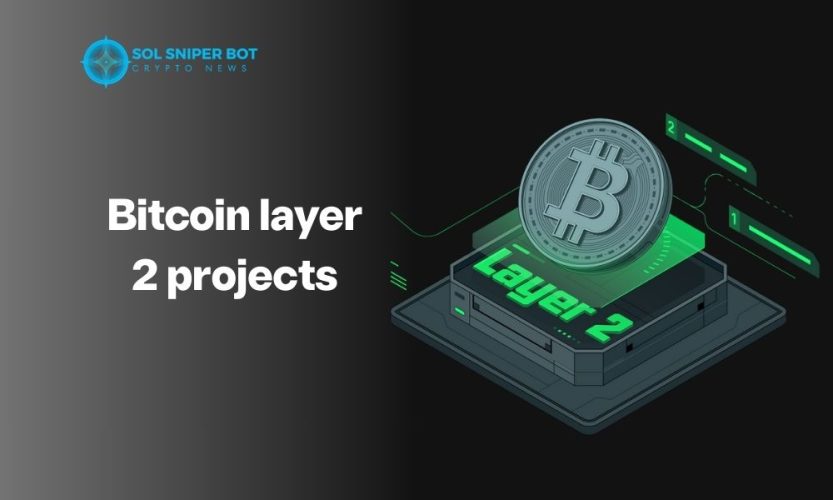In the ever evolving world of cryptocurrency, bitcoin layer 2 projects are emerging as groundbreaking solutions, addressing the scalability and transaction speed limitations of Bitcoin. These projects enhance Bitcoin’s functionality while maintaining its security and decentralization. This article will explore the significance of Layer 2 and the promising projects shaping the future of Bitcoin.
Contents
What are bitcoin layer 2 projects?

Bitcoin layer 2 projects are a set of solutions designed to enhance Bitcoin’s scalability and transaction speed without compromising its decentralization and security. These projects operate on top of the Bitcoin blockchain, adding additional layers to enable faster and more efficient transactions. While Bitcoin’s main blockchain (Layer 1) is secure, it faces limitations when handling a high volume of transactions due to its slower processing speed and higher transaction fees during periods of high demand.
Layer 2 projects aim to solve these problems by creating off chain systems that handle transactions and data processing separately from the main blockchain. One of the most well known bitcoin layer 2 solutions is the Lightning Network. The Lightning Network allows for off chain transactions between parties, significantly reducing transaction costs and increasing transaction speed. By utilizing smart contracts and payment channels, Bitcoin users can conduct numerous transactions without waiting for each one to be confirmed on the main blockchain, thus reducing congestion on the network.
Why bitcoin layer 2 projects are becoming a trend?
As the demand for Bitcoin continues to grow, expansion solutions like bitcoin layer 2 projects are becoming the center of attention. These projects not only address Bitcoin’s limitations in transaction speed and fees but also expand its range of applications. Let’s explore the main reasons why this trend is booming in the blockchain world.
- Overcoming the limitations of Bitcoin Layer 1: Bitcoin can handle only about seven transactions per second, leading to network congestion and skyrocketing transaction fees during periods of high demand. Bitcoin Layer 2 solves this issue by processing transactions off-chain, helping to relieve the main network, increase transaction speeds, and reduce costs for users.
- Expanding applications: Projects like Rootstock and Merlin Chain are actively integrating smart contracts, DeFi, and NFTs into the Bitcoin ecosystem. This opens new opportunities for decentralized applications to thrive on Bitcoin, a development previously common only on blockchains like Ethereum, making Bitcoin more versatile in the decentralized finance landscape.
- Attracting investment: According to statistics, the number of Bitcoin Layer 2 has increased sevenfold from 2021 to 2024, reflecting the sector’s explosive growth. Notably, more than 36% of total venture capital invested in blockchain in 2024 was allocated to Bitcoin Layer 2, demonstrating strong investor confidence in the long-term potential of this technology.
Notable bitcoin layer 2 pprojects in 2025
Several bitcoin layer 2 projects are gaining attention, each offering unique solutions to Bitcoin’s challenges. Here are some of the most notable projects in 2025.
Lightning network
Lightning Network is one of the most prominent Bitcoin Layer 2 projects. It enables fast and cost effective transactions by creating off-chain payment channels between users. These channels allow unlimited transactions, only recording the final payment on the Bitcoin blockchain. This significantly reduces the load on the main Bitcoin chain while ensuring faster processing times.
Lightning network stands out due to its high level of maturity and widespread adoption. Its ability to scale Bitcoin and facilitate instant payments globally makes it a critical platform in the Layer 2 ecosystem. Many exchanges and merchants use it to process Bitcoin transactions instantly and efficiently.
Rootstock (RSK)
Rootstock (RSK) is a smart contract platform integrated with Bitcoin through a sidechain, making it one of the most innovative bitcoin layer 2 projects. RSK enables developers to build decentralized applications (dApps) and execute complex smart contracts using Bitcoin as the native currency. This creates new opportunities for decentralized finance (DeFi) and non-fungible tokens (NFTs) on Bitcoin, an area traditionally dominated by Ethereum.
With the evolution of Bitcoin scaling solutions, RSK’s ability to introduce smart contract functionality to Bitcoin places it at the forefront of expanding the Bitcoin ecosystem. It bridges the gap, allowing Bitcoin to participate in areas like DeFi and NFTs, which were once dominated by other networks like Ethereum. This represents a significant step in bringing greater innovation to Bitcoin’s capabilities.
Stacks
Stacks is a unique addition to bitcoin layer 2 projects, enabling smart contracts and decentralized applications (dApps) while maintaining a connection to the Bitcoin blockchain. It uses the Proof of Transfer (PoX) mechanism, rewarding participants with Bitcoin for helping to secure the network. This approach builds a solid bridge between Bitcoin’s renowned security and the flexible nature of smart contracts. Stacks enhances Bitcoin’s functionality without changing its foundational protocol. Its innovative model positions it as a strong player in the next phase of blockchain development.
By cultivating a dynamic dApp ecosystem, Stacks demonstrates how Bitcoin’s role in technology can expand beyond a simple store of value. Developers gain the ability to create new applications while relying on Bitcoin’s security layer. This opens the door for broader use cases and a richer, more diverse blockchain economy. Stacks not only elevates Bitcoin’s capabilities but also paves the way for fresh innovations. Its growing ecosystem signals exciting opportunities for both users and builders alike.
The impact of bitcoin layer 2 projects on the crypto market

The rise of bitcoin layer 2 projects is bringing clear and positive effects to the broader crypto market, particularly by significantly reducing transaction fees. With off-chain processing mechanisms, users can execute transactions with minimal costs, often below $0.01 for micro transactions. This makes it easier to adopt Bitcoin for everyday payments. The affordability also allows Bitcoin to better compete with other payment-focused coins. Moreover, it opens financial access for users in emerging markets.
Beyond cost savings, bitcoin layer 2 also plays a vital role in expanding the ecosystem of users. Cross-chain compatibility, like Rootstock’s integration with Ethereum and Merlin Chain’s multi-asset support, provides developers with more options to build on Bitcoin. This helps attract a large number of developers from other platforms to explore Bitcoin’s potential. A growing community results in increased activity and liquidity.
In addition, real world use cases of bitcoin layer 2 are gradually reshaping how we view blockchain technology. Projects like Dovi and Liquid Network are pioneering cross border payment integrations, offering users faster and cheaper global transactions. At the same time, the tokenization of traditional assets such as stocks and bonds is being tested on these platforms. This increases Bitcoin’s utility in traditional finance. With this momentum, Bitcoin is increasingly asserting its role as the foundation for breakthrough innovations in the blockchain industry.
At Sol Sniper Bot, we continue to monitor and analyze the evolution of Bitcoin Layer 2 projects and their transformative role in the crypto space. As these technologies reshape Bitcoin’s utility and drive adoption across new markets, staying informed becomes essential. Whether you’re a developer, investor, or blockchain enthusiast, following these developments gives you a strategic edge in the ever changing world of crypto.
